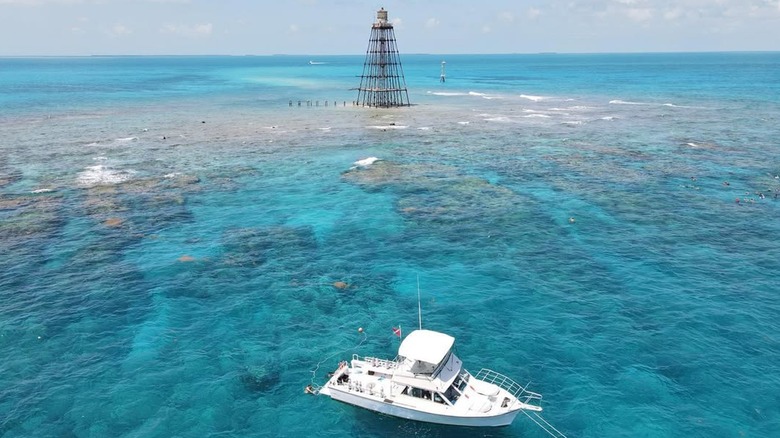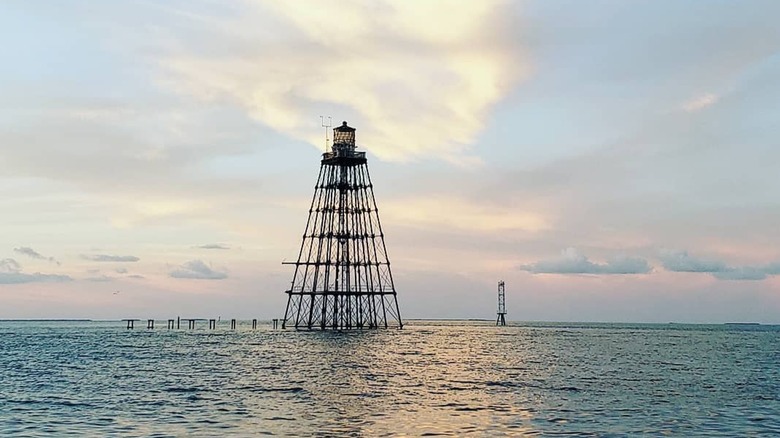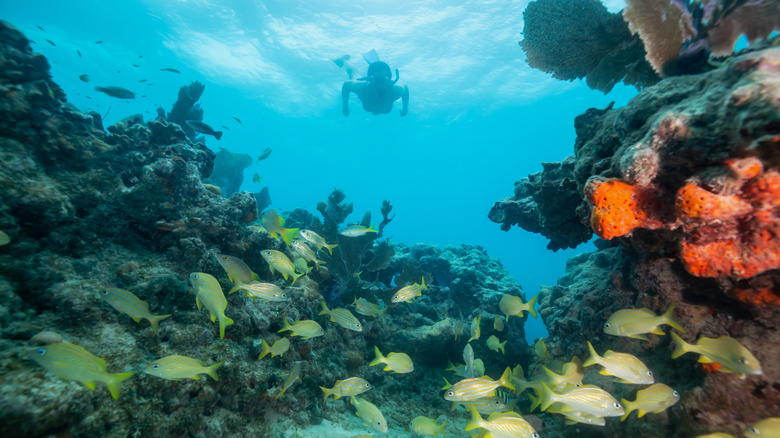This Quirky Off-Shore Lighthouse In Key West Guards Florida's Snorkeling Paradise Of Coral Towers
About six miles southwest of Key West, the southernmost point of the continental U.S., the Sand Key Lighthouse stands tall on a shallow reef that has long posed a hazard to passing ships. First built in the 1800s, the lighthouse was constructed to warn sailors of the hidden reef on which it rests. While steeped in history, today, this quirky lighthouse's primary job is to guard the coral reef paradise that shares its name. Sand Key is famous for its distinctive spur-and-groove reef formations and coral towers. At 27 feet deep, it's a relatively shallow snorkeling and diving site, making it ideal for new divers and snorkelers. The underwater scenery is breathtaking, much like Key Largo, the nearby Florida Keys island with the most stunning coral reef snorkeling in the state.
The Florida Keys sit alongside the Gulf Stream, a powerful ocean current that originates in the Gulf of Mexico, also known as the Gulf of America. The current helps ships travel along the East Coast and across the Atlantic towards Europe. It is known to have been used by Spanish galleons as far back as 1513. But in the tracks of this busy maritime corridor lies the deceptive archipelago of shallow banks and barely submerged reefs of Key West. Before the invention of GPS navigation and lighthouses, the Keys caused so many shipwrecks that "wrecking" — salvaging goods and rescuing passengers from stranded vessels in exchange for rewards — became a significant part of the Florida Keys economy.
Sand Key is one of six cast-iron lighthouses in the Florida Keys. Unlike the classic conical structure you might imagine when you think of a lighthouse, these offshore structures feature a skeletal base with deep foundations bored into the coral reef. This unique structure gives them a better chance of surviving hurricanes, which are common to the region.
The dramatic history of the Sand Key Lighthouse
The original lighthouse, a traditional brick tower, was built in 1827. Over nearly two centuries, it's safe to say it has witnessed its fair share of historic storms, casualties, and even fires. The lighthouse also felt the full force of two major hurricanes.
In 1830, the keeper of the lighthouse was a woman named Rebecca Flaherty, who took over the role after her husband, the original keeper, passed away suddenly. Years later, one of the most colorful figures to serve as keeper was Joshua Appleby. Before he got the job, he was arrested for deliberately causing shipwrecks. He was released before taking up his position at Sand Key in 1837. His tenure as keeper was tragically cut short when he and several others were killed during the 1846 Great Havana Hurricane, a devastating storm that caused the entire lighthouse to be swept away.
In 1853, Sand Key Lighthouse was rebuilt using more than 450 tons of iron, with a 134-foot skeletal design and a screw-pile foundation. This new structure allowed swell and wind to pass through its base. The last keeper left in 1941, not long after the U.S. Coast Guard took over operations. Though the lighthouse still towers over the reef below, its beacon has been dark since 2014. It's tough to picture the days when keepers lived in this rusty, isolated structure, devoting their lives to maritime safety for more than a century. Today, it has a new reputation as a popular spot for aquatic adventures.
Float above coral towers on a Sand Key snorkeling trip
Sand Key is home to one of the top beginner-friendly dive and snorkel sites in the Florida Keys. The reef is shallow, bathed in sunlight, and typically calm with no heavy currents, offering clear visibility ranging from 15 to 110 feet, depending on conditions. It's part of the Sand Key Sanctuary Preservation Area, which protects over 286 acres of vibrant spur-and-groove reefs and the region's diverse marine life.
Thanks to ongoing preservation efforts, the Sand Key reef has flourished with barely any human intervention, besides the occasional snorkeling trip. The area is teeming with angelfish, porcupine pufferfish, parrot fish, schools of yellowtail, and even some feisty barracuda. If you keep your eyes peeled, you might spot a moray eel peeping its head out of the reef, a friendly turtle, and eagle rays gliding above the fanning coral. Occasionally, divers come across brick remains and rusted debris from the original lighthouse. Taking water temperature, air temperature, and visibility into account, the best month to snorkel at Sand Key is June.
The closest major city within driving distance is Miami, located just under four hours away along the US-1 Highway. The road trip from Miami to Key West takes you through the entire chain of the Florida Keys, crossing iconic bridges like the Seven Mile Bridge, the Keys' longest scenic bridge. To access the reef, you'll need to join a guided tour departing from Key West. Finz Dive Center runs charters to Sand Key, offering both snorkel tours and dive expeditions. Casual Monday Charters also offers boat excursions to offshore islands and sandbars around Key West.


